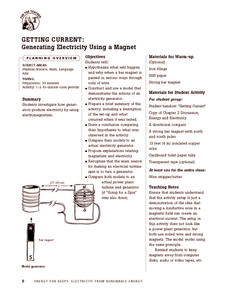Curated OER
Magnetic Fields and Forces Homework/Electromagnetic Induction Homework
Here are two electromagnetism homework assignments rolled into one. The first eight practice problems deal with the magnetic field and magnetic force exerted by current-carrying wires. The second set of seven problems are specific to...
Lincoln Public Schools
Cell Exploration Activities
Engage young biologists in exploring the mysteries of life with this collection of hands-on activities. Enlisting the help of numerous digital resources, students get an up-close look at the structure of plant and animal...
Energy for Keeps
Getting Current: Generating Electricity Using a Magnet
Give your class a magnetic charge with this creative experiment designed to teach emerging scientists about electromagnetism. Pupils construct a model that demonstrates the function of an electrical generator and test this creation in a...
Polar Trec
Why Can’t I Eat This Fish?
Can turning on the television lead to toxins in the food supply? The lesson offers an opportunity for young scientists to complete guided research. A worksheet lists each question as well as the web page necessary to answer the question....
BBC
Rivers
The water cycle, rainfall, and the flow of water into rivers then out into the ocean are the main ideas covered here. After a teacher-led discussion and activity, learners pair off and write a commentary about the water cycle that is to...
Curated OER
Rate and Concentration
Experimental data for a chemical reaction is available in a table. Chemistry cohorts use critical thinking skills to analyze the data and answer questions about reaction rates and reaction order. This worksheet is neatly formatted,...
Curated OER
WS 8.4 Percentage Problems
In this percentage worksheet, students calculate percentages given various types of problems. They calculate percent of compounds in a solution, they calculate mass of compounds given percentages of solutions, and they percentages of...
Curated OER
WS 4.4 Stoichiometry Part 2
Four balanced chemical equations are presented for your pupils to analyze. They identify limiting reagents and use dimensional analysis to compute products. This practical worksheet is one that you will want to keep in your repertoire to...
Curated OER
WS 7.4 Ideal Gas Law
In this ideal gas law worksheet, young scholars solve eighteen problems using the ideal gas law to solve for moles of gases, temperature of gases, pressure of gases or volumes of gases.
Curated OER
The Chemical Building Blocks of Life
Amateur biologists examine the macromolecules that are foundational to life: proteins, lipids, and carbohydrates. This worksheet is composed of five pages of questions and plenty of space to write answers. Learners will explore...
Curated OER
Chapter 14 Review, Section 3: Acids and Bases
Aside from a mention of a textbook page, this chemistry assignment is a suitable review of acids and bases. It begins by addressing conjugate pairs and acid base reactions. Neutralization and amphoteric properties are also dealt with....
Curated OER
Chapter 14 Review/Acids and Bases
Two pages take chemistry learners on a survey of acids and bases. High schoolers write formulas and name compounds. They identify conjugate bases and acids with the aid of a table (not provided). On the second page, two different acids...
Curated OER
Recombination and Pedigrees
Biology aces answer four questions about genetic recombination and nine questions about pedigrees. This worksheet is very focused on these two topics. Most of the pedigree questions relate to the genetic disorders, Alkaptonuria and...
Education Outside
Creature Jeopardy!
After conducting research on a given scientific animal name, group members take a walk around their school and look for the specified animals in that classification. Then, they come back to their worksheets and create five creative clues...
Polar Trec
Drawing Diatoms like Ernst Haeckel
Why do scientists rely on drawings rather than just photographs of their research studies? The lesson introduces drawings of microscopic organisms and the importance of accuracy. Young artists draw organisms and learn why focus and...
Curated OER
Wave Practice Problems
Physics scholars list the properties of waves and calculate the speed, wavelength, and frequency of waves. The worksheet is concise, but covers a variety of wave computational skills. The formatting is neat, but it does have small...
K12 Reader
What’s Eating You?
Introduce your class to producers, consumers, and pollinators with a reading passage. Class members read the text and respond to five related questions.
NASA
Cleaning Water
From their sweat to the water vapor in their breath, astronauts recycle every possible drop of water while in space. After watching a short video describing the different ways materials are recycled and reused in space...
Curated OER
Scavenger Hunt: Home Sweet Habitat
In this animal habitat worksheet, learners participate in a scavenger hunt that involves an in-depth study of animal habitats and then correlates that concept to the student's own personal habitat's.
Curated OER
Chemistry 142 Exam 1
In this chemistry exam worksheet, students solve fifteen problems related to acids and bases, rates of reactions, and half life.
Curated OER
WS 1.7 Density /Archimedes Principle
Archimedes' principle is practiced as chemistry learners practice computing the density of different gases, liquids, and solids. Using a chart of standard densities, they also identify unknown materials by similar calculations. Fifteen...
Curated OER
WS 1.7 Density
In this density worksheet, students calculate the density of objects given their mass and volume. They are given a table with the density of a variety of substances and given the mass or volume and must find the unknown.
Curated OER
WS 8.8 Molality and Colligative Properties
In this molality and colligative properties worksheet, students determine the molality of solutions and they calculate freezing point depressions and boiling point elevations of solutions.
Curated OER
Atoms, Mass and The Mole
In this atoms, mass and the mole worksheet, students are given 18 problems to solve for the number of atoms, the mass of the substance or the moles of the substance. Students show their work and include all the units of measurements.























